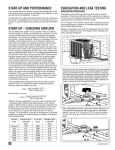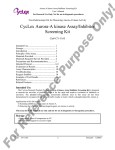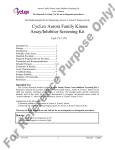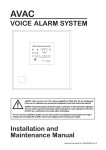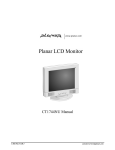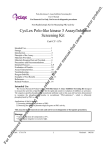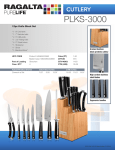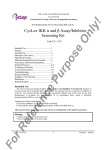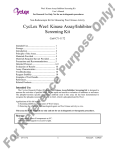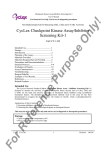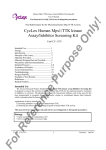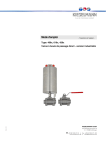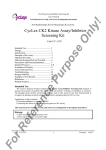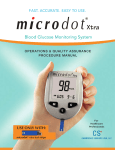Download Data Sheet
Transcript
ly ! Non-Radioisotopic Kit for Measuring Plk2 Activity On Polo-like kinase 2 Assay/Inhibitor Screening Kit User’s Manual For Research Use Only, Not for use in diagnostic procedures Cat# CY-1183 en ce Pu rp Intended Use................................................ 1 Storage......................................................... 1 Introduction ................................................. 2 Principle of the Assay.................................. 3 Materials Provided ...................................... 4 Materials Required but not Provided .......... 5 Precautions and Recommendations............. 6 Detailed Protocol......................................... 7-10 Evaluation of Results ................................. 11 Assay Characteristics ................................. 11 Troubleshooting ..........................................11 Reagent Stability ........................................ 11 Example of Test Result................................12-13 References....................................................14 Related Products...........................................14 os e CycLex Polo-like kinase 2 Assay/Inhibitor Screening Kit Intended Use The CycLex Research Product CycLex Polo-like kinase 2 Assay/Inhibitor Screening Kit is designed to measure the activities of purified Polo-like kinase 2 (Plk2) for the rapid and sensitive evaluation of inhibitors using recombinant Plk2. The phospho-threonine specific polyclonal antibody used in this assay kit has been demonstrated to recognize the phospho-threonine residue in recombinant “Plk2-substrate”, which is efficiently phosphorylated by Plk2. er * “Plk2-substrate” is CycLex’s intellectual property. ef Applications of this kit include: 1) Screening inhibitors or activators of Plk2. 2) Detecting the effects of pharmacological agents on Plk2 activity. This assay kit is for research use only and not for use in diagnostic or therapeutic procedures. rR Storage • Upon receipt store all components at 4°C. • Don’t expose reagents to excessive light. Fo Cat#: CY-1183 1 Version#: 120420 On Introduction ly ! Polo-like kinase 2 Assay/Inhibitor Screening Kit User’s Manual For Research Use Only, Not for use in diagnostic procedures en ce Pu rp os e Polo-like kinases (Plks) have been shown to be important contributors to several cell-cycle events (1,2). Genetic and biochemical experiments in various organisms indicate that polo-like kinases regulate diverse cellular events at multiple mitotic stages. Genetic studies in Drosophila and yeast indicate plks function in centrosome assembly and separation during the formation of the bipolar spindle. Drosophila polo mutants reveal phenotypes of hyper-condensed chromosomes, monopolar spindles, disorganized spindle poles, and abnormal chromosome segregation (3). Schizosaccharomyces pombe plo1 displays similar phenotypes, such as the formation of monopolar spindles or a failure in septum formation after nuclear division (4). The budding yeast polo-like kinase homolog, Cdc5, seems to play an important role in actin ring formation and cytokinesis (5). Plk2, also called Snk, a member of polo-like kinase family, was originally identified as immediate-to-early transcripts in mouse fibroblasts (6), however it is expressed at mainly in the hippocampal neurons in the brains of adult rodents. The level of Plk2 in the brain is increased by stimuli that induce long-term potentiation (7). When ectopically expressed, Plk2 caused changes in cell morphology and, after an extended period of time, cell death (8). The precise function of Plk2 is uncertain. However, from analysis of Plk2-/- mice, it appears that the protein has a role in development and is involved in cell-cycle progression (9). Plk2 protein is expressed at equal abundance during G1, S, and G2 phases in HeLa cell. In contrast, Plk2 kinase activity peaked as near the G1-to-S transition and decreased again as cells entered G2 phase of the cell cycle (10). Endogenous Plk2 localize with centrosomes, and this interaction is independent of Plk2 kinase activity. In contrast, the kinase activity of Plk2 is required for centriole duplication. These results show that Plk2 is a physiological centrosomal protein and that its kinase activity is likely to be required for centriole duplication near the G1-to-S phase transition (10). There is also evidence that Plk2 functions as a stress response protein. Expression of Plk2 is directly induced by wild-type p53 after DNA damage and in these circumstances activates a G2 checkpoint (11). Measurement of Polo-like kinase 2 activity rR ef er The protocol generally regarded as most sensitive for the quantitative measurement of Plk2 activity involves incubation of the Plk2 sample with exogenous substrate, such as α-casein or MBP, in the presence of Mg2+and 32P-labeled ATP. The reaction is terminated by "spotting" a sample onto a filter paper disc, followed by immersion in acid to precipitate the radiolabeled product. The filter papers are then washed extensively to remove unincorporated radiolabel and the radioactivity counted. While sensitive, this method is labor-intensive, generates hazardous radioactive waste and depends on a radioisotope of short half-life. It is particularly unsuitable when kinase assays are only performed on an infrequent basis. The CycLex Polo-like kinase 2 Assay/Inhibitor Screening Kit uses anti-phospho-threonine polyclonal antibody (PPT-08) and peroxidase coupled anti-rabbit IgG antibody as a reporter molecule in a 96-well ELISA format. This assay provides a non-isotopic, sensitive and specific method to measure the activities of Plk2. Fo Cat#: CY-1183 2 Version#: 120420 On Principle of the Assay ly ! Polo-like kinase 2 Assay/Inhibitor Screening Kit User’s Manual For Research Use Only, Not for use in diagnostic procedures rp os e The CycLex Research Product CycLex Polo-like kinase 2 Assay/Inhibitor Screening Kit is a single-site, semi-quantitative immunoassay for Plk2 activity. Plates are pre-coated with a substrate corresponding to recombinant “Plk2-substrate”, which contains threonine residues that can be efficiently phosphorylated by Plk2. The detector antibody specifically detects only the phosphorylated form of threonine residue on “Plk2-substrate”. The CycLex Polo-like kinase 2 Assay/Inhibitor Screening Kit may be used to study the kinetics of a purified Plk2 as well as to screening Plk2 inhibitor or activator. To perform the test, the sample is diluted in Kinase Buffer, pipetted into the wells and allowed to phosphorylate the bound substrate following the addition of Mg2+ and ATP. The amount of phosphorylated substrate is measured by binding it with a PPT-08, a anti-phospho-threonine polyclonal antibody, followed by binding with horseradish peroxidase conjugated anti-rabbit IgG, which then catalyzes the conversion of the chromogenic substrate tetra-methylbenzidine (TMB) from a colorless solution to a blue solution (or yellow after the addition of stopping reagent). The color is quantitated by spectrophotometry and reflects the relative amount of Plk2 activity in the sample. For kinetic analysis, the Plk2 containing sample is added to the wells in a similar fashion and at varying times the reaction is stopped by the addition of the chelator, sodium ethylenediaminetetraacetate (EDTA) and the amount of phosphorylated substrate determined as before. Pu Summary of Procedure Add 100 µL of sample to the wells Incubate for 60 min at 30°C en ce Wash the wells Add 100 µL of anti-phospho-threonine polyclonal antibody (PPT-08) Incubate for 60 min at room temp. Wash the wells Add 100 µL of HRP conjugated anti-rabbit IgG Incubate for 60 min at room temp. er Wash the wells ef Add 100 µL of Substrate Reagent rR Add 100 µL of Stop Solution Fo Cat#: CY-1183 Measure absorbance at 450 nm 3 Version#: 120420 On Materials Provided ly ! Polo-like kinase 2 Assay/Inhibitor Screening Kit User’s Manual For Research Use Only, Not for use in diagnostic procedures All samples and standards should be assayed in duplicate. The following components are supplied and are sufficient for the one 96-well microtiter plate kit. os e Microplate: One microplate supplied ready to use, with 96 wells (12 strips of 8-wells) in a foil, zip-lock bag with a desiccant pack. Wells are coated with recombinant “Plk2 substrate” as Plk2 substrate. 10X Wash Buffer: One bottle containing 100 mL of 10X buffer containing 2 %Tween®-20 Kinase Buffer: One bottle containing 20 mL of Kinase Buffer. Used for Kinase Reaction Buffer and sample dilution. 20X DTT Solution: One tube containing 1.2 mL of 20X DTT Solution. rp 20X ATP: Lyophilized ATP Na2 salt. Pu Anti-Phospho-Threonine Polyclonal Antibody (PPT-08): One bottle containing 12 mL of anti-phospho-threonine polyclonal antibody (PPT-08). Ready to use. HRP conjugated Anti-rabbit IgG: One bottle containing 12 mL of HRP (horseradish peroxidase) conjugated anti-rabbit IgG. Ready to use. Substrate Reagent: One bottle containing 20 mL of the chromogenic substrate, tetra-methylbenzidine (TMB). Ready to use. rR ef er en ce Stop Solution: One bottle containing 20 mL of 1 N H2SO4. Ready to use. Fo Cat#: CY-1183 4 Version#: 120420 On Materials Required but not Provided ly ! Polo-like kinase 2 Assay/Inhibitor Screening Kit User’s Manual For Research Use Only, Not for use in diagnostic procedures • Plk2 Positive Control: Available from CycLex (Plk2 Positive Control: Cat# CY-E1183, One vial containing 10 units/100 µL (100 m units/µL) Plk2 enzyme. Positive control should be added to the first well at ca. 50 m units/well. Unused Plk2 enzyme should be stored in aliquots at below -70°C. os e • 10X Plk Inhibitor I (250 µM): Plk Inhibitor I is available from Calbiochem, Cat#. 528282. 10 mM stock solution (DMSO) diluted 1:40 in Kinase Buffer. • Pipettors: 2-20 µL, 20-200 µL and 200-1000 µL precision pipettors with disposable tips. • Precision repeating pipettor. • Microcentrifuge and tubes for sample preparation. • Vortex mixer rp • Wash bottle or multichannel dispenser for plate washing. • 500 or 1000 mL graduated cylinder Pu • Plate reader capable of measuring absorbance in 96-well plates at dual wavelengths of 450 nm/540 nm. Dual wavelengths of 450/550 or 450/595 nm can also be used. The plate can also be read at a single wavelength of 450 nm, which will give a somewhat higher reading. en ce • Reagent reservoirs • Deionized water of the highest quality rR ef er • Disposable paper towels Fo Cat#: CY-1183 5 Version#: 120420 ly ! Precautions and Recommendations On Polo-like kinase 2 Assay/Inhibitor Screening Kit User’s Manual For Research Use Only, Not for use in diagnostic procedures • Store the Plk2 enzyme at below -70°C and the ATP at -20°C when not in use. Store all other components at 4°C. Do not expose reagents to excessive light. Avoid freeze/thaw cycles. • Allow all the components to come to room temperature before use. os e • All microplate strips that are not immediately required should be returned to the zip-lock pouch, which must be carefully resealed to avoid moisture absorption. • Do not use kit components beyond the indicated kit expiration date. • Use only the microtiter wells provided with the kit. rp • Rinse all detergent residue from glassware. • Use deionized water of the highest quality. Pu • Do not mix reagents from different kits. • The buffers and reagents used in this kit contain either sodium Kathon-CG as preservatives. Care should be taken to avoid direct contact with these reagents. • Do not mouth pipette or ingest any of the reagents. en ce • Do not smoke, eat, or drink when performing the assay or in areas where samples or reagents are handled. • Dispose of tetra-methylbenzidine (TMB) containing solutions in compliance with local regulations. • Avoid contact with Substrate Solution which contains hydrogen peroxide. • Avoid contact with Stop Solution which contains Sulfuric Acid. er • In case of contact with the Stop Solution and the Substrate Solution, wash skin thoroughly with water and seek medical attention, when necessary. • Biological samples may be contaminated with infectious agents. Do not ingest, expose to open wounds or breathe aerosols. Wear protective gloves and dispose of biological samples properly. rR ef • CAUTION: Sulfuric Acid is a strong acid. Wear disposable gloves and eye protection when handling Stop Solution. Fo Cat#: CY-1183 6 Version#: 120420 On Detailed Protocol ly ! Polo-like kinase 2 Assay/Inhibitor Screening Kit User’s Manual For Research Use Only, Not for use in diagnostic procedures os e The CycLex Polo-like kinase 2 Assay/Inhibitor Screening Kit is provided with removable strips of wells so the assay can be carried out on separate occasions using only the number of strips required for the particular determination. Since conditions may vary, running an aliquot of the appropriate Plk2 positive control (Cat# CY-E1183), separately available from CycLex, should be included in each assay. Disposable pipette tips and reagent troughs should be used for all transfers to avoid cross-contamination of reagents or samples. Preparation of Working Solution 1. Prepare a working solution of Wash Buffer by adding 100 mL of the 10X Wash Buffer (provided) to 900 mL of ddH2O. Mix well. Store at 4°C for two weeks or -20°C for long-term storage. rp 2. Prepare 20X ATP Solution by adding 1.6 mL of ddH2O to the vial of 20X ATP (provided, lyophilized). Mix gently until dissolved. The final concentration of the 20X ATP Solution should be 1.25 mM. Store the solution in small aliquots (e.g. 100 µL) at -20°C. Pu 3. Prepare Kinase Reaction Buffer (DTT & ATP plus) by mixing following reagents. 10 assays 1 assay 9.0 mL 0.5 mL 0.5 mL 900 µL 50 µL 50 µL 90 µL 5 µL 5 µL 1000 µL 100 µL en ce Kinase Buffer (provided) 20X DTT Solution (provided) 20X ATP Solution 96 assays Total 10 mL You will need 80-90 µL of Kinase Reaction Buffer (DTT & ATP plus) per assay well. Mix well. Discard any unused Kinase Reaction Buffer (DTT & ATP plus) after use. Standard Assay er 1. Remove the appropriate number of microtiter wells from the foil pouch and place them into the well holder. Return any unused wells to the foil pouch, refold, seal with tape and store at 4°C. 2. Prepare all samples (diluted with Kinase Buffer. as needed). All samples should be assayed in duplicate. ef 3. Add 10 µL of individual purified Plk2 sample to the well of the assay plate on ice. Duplicate wells containing 50 m units/10 µL of Plk2 positive control (Cat # CY-E1183) should be included in each assay as a positive control for phosphorylation. rR 4. Begin the kinase reaction by addition of 90 µL Kinase Reaction Buffer per well, cover with plate sealer or lid, and incubate at 30°C for 60 minutes. 5. Wash wells five times with Wash Buffer making sure each well is filled completely. Remove residual Wash Buffer by gentle tapping or aspiration. Fo Cat#: CY-1183 7 Version#: 120420 ly ! On Polo-like kinase 2 Assay/Inhibitor Screening Kit User’s Manual For Research Use Only, Not for use in diagnostic procedures 6. Pipette 100 µL of Anti-Phospho-Threonine Polyclonal Antibody PPT-08 into each well, cover with plate sealer or lid, and incubate at room temperature (ca.25°C) for 60 minutes. Discard any unused antibody after use. 7. Wash wells five times as same as in step 5. os e 8. Pipette 100 µL of HRP-conjugated Anti-rabbit IgG into each well, cover with plate sealer or lid, and incubate at room temperature (ca.25°C) for 60 minutes. Discard any unused conjugate after use. 9. Wash wells five times as same as in step 7. rp 10. Add 100 µL of Substrate Reagent to each well and incubate at room temperature (ca.25°C) for 5–15 minutes. (Appropriate incubation time may vary, and incubation time can be extended up to 20 minutes if the reaction temperature is below than 20°C). Pu 11. Add 100 µL of Stop Solution to each well in the same order as the previously added Substrate Reagent. 12. Measure absorbance in each well using a spectrophotometric plate reader at dual wavelengths of 450/540 nm. Dual wavelengths of 450/550 or 450/595 nm can also be used. Read the plate at 450 nm if only a single wavelength can be used. Wells must be read within 30 minutes of adding the Stop Solution. en ce Note-1: Complete removal of liquid at each step is essential to good performance. After the last wash, remove any remaining Wash Buffer by aspirating or decanting. Invert the plate and blot it against clean paper towels. Note-2: Reliable signals are obtained when either O.D. values do not exceed 0.3 units for the blank (no enzyme control), or 2.5 units for the 50 m units/well of Plk2 positive control (Cat# CY-E1183). Note-3: If the microplate reader is not capable of reading absorbance greater than the absorbance of the Plk2 positive control, perform a second reading at 405 nm. A new O.D. values, measured at 405 nm, is used to determine Plk2 activity of off-scale samples. The readings at 405 nm should not replace the on-scale readings at 450 nm. er Kinetic Assays 1. Remove the appropriate number of microtiter wells from the foil pouch and place them into the well holder. Return any unused wells to the foil pouch, refold, seal with tape and store at 4°C. ef 2. Prepare all samples (diluted with Kinase Buffer. as needed). rR 3. Add 10 µL of individual purified Plk2 sample to the well of the assay plate on ice. Duplicate wells containing 50 m units/10 µL of Plk2 positive control (Cat # CY-E1183) should be included in each assay as a positive control for phosphorylation. 4. Begin the kinase reaction by addition of 90 µL Kinase Reaction Buffer in duplicate per well in timed intervals (suggested interval is 4 minutes but should be individually determined for each system). After the final addition, cover with plate sealer or lid, and incubate at 30°C for 20 minutes. Fo Cat#: CY-1183 8 Version#: 120420 On ly ! Polo-like kinase 2 Assay/Inhibitor Screening Kit User’s Manual For Research Use Only, Not for use in diagnostic procedures 5. Stop the reaction by flicking out the contents. (Alternatively, the reaction may be terminated by the addition of 150 µL 0.2 M Na EDTA, pH 8.0 to each well). 6. Wash wells five times with Wash Buffer making sure each well is filled completely. Remove residual Wash Buffer by gentle tapping or aspiration. os e 7. Pipette 100 µL of Anti-Phospho-Threonine Polyclonal Antibody PPT-08 into each well, cover with plate sealer or lid, and incubate at room temperature (ca.25°C) for 60 minutes. Discard any unused antibody after use. 8. Wash wells five times as same as in step 6. rp 9. Pipette 100 µL of HRP-conjugated Anti-rabbit IgG into each well, cover with plate sealer or lid, and incubate at room temperature (ca.25°C) for 60 minutes. Discard any unused conjugate after use. 10. Wash wells five times as same as in step 8. Pu 11. Add 100 µL of Substrate Reagent to each well and incubate at room temperature (ca.25°C) for 5-15 minutes. (Appropriate incubation time may vary, and incubation time can be extended up to 20 minutes if the reaction temperature is below than 20°C). 12. Add 100 µL of Stop Solution to each well in the same order as the previously added Substrate Reagent. en ce 13. Measure absorbance in each well using a spectorphotometric plate reader at dual wavelengths of 450/540 nm. Dual wavelengths of 450/550 or 450/595 nm can also be used. Read the plate at 450 nm if only a single wavelength can be used. Wells must be read within 30 minutes of adding the Stop Solution. Recommendations er Special considerations when screening activators or inhibitors In order to estimate the inhibitory effect on individual Plk2 activity in the test chemicals correctly, it is necessary to conduct the control experiment of “Solvent control” at least once for every experiment and “Inhibitor control” at least once for the first experiment, in addition to “Test sample”, as indicated in the following table. When test chemicals cause an inhibitory effect on Plk2 activity, the level of A450 is weakened as compared with “Solvent control”. The high level of A450 is not observed in “Inhibitor control” (usually A450<0.5). Inhibitor control 80 µL 10X Inhibitor or equivalent 10 µL - - Vehicle for Inhibitor - 10 µL - 10X Plk Inhibitor I (250 µM)* - - 10 µL ef 80 µL Solvent control 80 µL Test sample Kinase Reaction buffer (DTT & ATP plus) rR Assay reagents Fo Cat#: CY-1183 9 Version#: 120420 10 µL 10 µL 10 µL On Plk2 positive control (5 m units/µL)** or Purified enzyme sample ly ! Polo-like kinase 2 Assay/Inhibitor Screening Kit User’s Manual For Research Use Only, Not for use in diagnostic procedures * Calbiochem, Cat#. 528282: See Page 4, section “Materials Required but not Provided” ** Plk2 positive control: Cat# CY-E1183: See Page 5, section “Materials Required but not Provided” os e 1. Following the above table, add the Reagents to each well of the microplate. Finally, initiate reaction by adding 10 µL of “Plk2 positive control (5 m units/µL)” to each well and mixing thoroughly at room temperature. Cover with plate sealer or lid, and incubate at 30°C for 60 minutes. 2. Follow the Standard Assay steps 5-12, page 7-8. rp Note: Although we suggest to conduct experiments as outlined in the table above, the optimal experimental conditions will vary depending on the parameters being investigated, and must be determined by the individual user. Especially, appropriate amount of Plk2 positive control must be determined by titration of the Plk2 positive control and setting the amount, which shows OD value does not exceed plateau range in dose response curve. Pu NOTE: THE ABOVE PROCEDURES ARE INTENDED ONLY AS A GUIDELINE. THE OPTIMAL EXPERIMENTAL CONDITIONS WILL VARY DEPENDING ON THE PARAMETERS BEING INVESTIGATED, AND MUST BE DETERMINED BY THE INDIVIDUAL USER. NO WARRANTY OR GUARANTEE OF PERFORMANCE USING THESE PROCEDURES IS MADE OR IMPLIED. Special considerations when measuring precise Polo-like kinase 2 activity en ce In order to measure the activity of Plk2 correctly, it is necessary to conduct the control experiment of “Inhibitor control” at least once for every experiment and “ATP minus control” at least once for the first experiment, in addition to “No enzyme control” as indicated in the following table. Although the level of A450 increases in “Test sample” when Plk2 enzyme activity is in the sample, the high level of A450 is not observed in “Inhibitor control”, “ATP minus control” and “No enzyme control”. Test Sample 80 µL Inhibitor control 80 µL ATP minus control - Positive control 80 µL No enzyme control 80 µL Kinase Buffer (DTT plus, ATP minus) - - 80 µL - - 10X Plk Inhibitor I (250 µM)* - 10 µL - - - 10 µL 10 µL 10 µL 10 µL - 10 µL - 10 µL Assay reagents er Kinase Reaction buffer (DTT & ATP plus) 10 µL Your enzyme sample Plk2 positive control (5 m units/µL)** Buffer for your enzyme sample 10 µL - ef Vehicle for 10X Compound C 10 µL - * Calbiochem, Cat#. 528282: See Page 4, section “Materials Required but not Provided” ** Plk2 positive control: Cat# CY-E1183: See Page 5, section “Materials Required but not Provided” rR 1. Following the above table, add the Reagents to each well of the microplate. Finally, initiate the reaction by adding 10 µL of “Your enzyme sample” or “Buffer” to each well and mixing thoroughly at room temperature. Cover with plate sealer or lid, and incubate at 30°C for 60 minutes. 2. Follow the Standard Assay steps 5-12, page 7-8. Fo Cat#: CY-1183 10 Version#: 120420 On Evaluation of Results ly ! Polo-like kinase 2 Assay/Inhibitor Screening Kit User’s Manual For Research Use Only, Not for use in diagnostic procedures 1. Average the absorbance values for the Plk2 sample duplicates (positive control) and all experimental sample duplicate values (when applicable). When Plk2 positive control (50 m units/assay) is included as an internal control for the phosphorylation reaction, the absorbance value should be greater than 1.0 with a background less than 0.30. os e 2. For kinetic analysis, on graph paper, plot the mean absorbance values for each of the time points on the Y-axis versus the time of each reaction (minutes) on the X-axis. Assay Characteristics rp The CycLex Research Product CycLex Polo-like kinase 2 Assay/Inhibitor Screening Kit has been shown to detect the activity of purified recombinant Plk2. The assay shows good linearity of sample response. Troubleshooting Pu 1. The CycLex Plk2 positive control (Cat# CY-E1183) should be run in duplicate, when a standard assay is being performed, using the protocol described in the “Detailed Protocol”. Incubation times or temperatures significantly different from those specified may give erroneous results. en ce 2. The reaction curve is nearly a straight line if the kinetics of the assay is of the first order. Variations in the protocol can lead to non-linearity of the curve, as can assay kinetics of other than first order. For a non-linear curve, point to point or quadratic curve fit methods should be used. 3. Poor duplicates, accompanied by elevated values for wells containing no sample, indicate insufficient washing. If all instructions in the “Detailed Protocol” were followed accurately, such results indicate a need for washer maintenance. 4. Overall low signal may indicate that desiccation of the plate has occurred between the final wash and addition of Substrate Reagent. Do not allow the plate to dry out. Add Substrate Reagent immediately after wash. er Reagent Stability ef All of the reagents included in the CycLex Research Product CycLex Polo-like kinase 2 Assay/Inhibitor Screening Kit have been tested for stability. Reagents should not be used beyond the stated expiration date. Upon receipt kit reagents should be stored at 4°C, except the ATP must be stored at -20°C. Coated assay plates should be stored in the original foil bag sealed by the zip lock and containing a desiccant pack. rR For research use only, not for use in diagnostic or therapeutic procedures Fo Cat#: CY-1183 11 Version#: 120420 On Example of Test Results Fig.1 Dose dependency of recombinant Plk2 enzyme reaction Plk2 dose dependency os e 3.0 2.5 2.0 A450 ly ! Polo-like kinase 2 Assay/Inhibitor Screening Kit User’s Manual For Research Use Only, Not for use in diagnostic procedures 1.5 rp 1.0 0.0 0 25 50 Plk2 dose (mUnit) 75 100 en ce Fig.2 Dose dependency of ATP Pu 0.5 Dose dependency of ATP 3.0 2.5 1.5 er A450 2.0 1.0 ef 0.5 rR 0.0 Fo Cat#: CY-1183 0 20 40 60 ATP conc. (uM) 12 80 100 Version#: 120420 On Fig.3 Km for ATP (recombinant Plk2) Km for ATP 1200 os e 1000 800 600 y = 10.467x + 79.938 2 R = 0.9854 400 rp A450/min. <s/v> ly ! Polo-like kinase 2 Assay/Inhibitor Screening Kit User’s Manual For Research Use Only, Not for use in diagnostic procedures Km for ATP : 7.6 uM 200 0 Pu 0 10 20 30 40 50 60 70 80 90 100 ATP conc. (uM) en ce Fig.4 Effect of Polo-like Kinase specific inhibitor Polo-like Kinase Inhibitor I (Calbiochem) on Plk2 activity Inhibition by Plk Inhibitor I 2.0 er A450 1.5 1.0 rR ef 0.5 Fo Cat#: CY-1183 0.0 0 5 10 15 Plk Inhibitor I conc. (uM) 13 20 25 Version#: 120420 1. Lane, H. A. & Nigg, E. A. Trends Cell Biol. 7, 63-68, 1997 2. Glover, D. M., Hagan, I. M. & Tavares, A. A. M. Genes Dev. 12, 3777-3787, 1998 os e 3. Sunkel, C. E. & Glover, D. M. J. Cell Sci. 89, 25-38, 1988 On References ly ! Polo-like kinase 2 Assay/Inhibitor Screening Kit User’s Manual For Research Use Only, Not for use in diagnostic procedures 4. Ohkura, H., Hagan, I. & Glover, D. M. Genes Dev. 9, 1059-1073, 1995 5. Song, S. & Lee, K. S. J. Cell Biol. 152, 451-469, 2001 6. Simmons DL, Neel BG, Stevens R, Evett G, et al. Mol Cell Biol. 12, 4164-4169, 1992 rp 7. Kauselmann, G., M. Weiler, P. Wulff, et al.. EMBO J. 18, 5528–5539, 1999 8. Ma, S., M.-Y. Liu, Y.-L. O. Yuan, and R. L. Erikson. Mol. Cancer Res. 1, 376–384, 2003 Pu 9. Ma S, Charron J, Erikson R. Mol Cell Biol. 23, 6936-6943, 2003 10. S Warnke, S Kemmler, RS Hames, HL Tsai, et al. Curr Biol, 14, 1200-1207, 2004 11. Burns TF, Fei P, Scata KA, et al. Mol Cell Biol. 23, 5556-5571, 2003 en ce Related Products * Plk1 Positive control: Cat# CY-E1163 * Plk2 Positive control: Cat# CY-E1183 * Plk3 Positive control: Cat# CY-E1176 * CycLex Polo-like kinase 1 Assay/Inhibitor Screening Kit: Cat# CY-1163 * CycLex Polo-like kinase 2 Assay/Inhibitor Screening Kit: Cat# CY-1183 * CycLex Polo-like kinase 3 Assay/Inhibitor Screening Kit: Cat# CY-1176 er PRODUCED BY ef CycLex Co., Ltd. 1063-103 Terasawaoka Ina, Nagano 396-0002 Japan Fax: +81-265-76-7618 e-mail: [email protected] URL: http://www.cyclex.co.jp rR CycLex/CircuLex products are supplied for research use only. CycLex/CircuLex products and components thereof may not be resold, modified for resale, or used to manufacture commercial products without prior written approval from CycLex Co., Ltd.. To inquire about licensing for such commercial use, please contact us via email. Fo Cat#: CY-1183 14 Version#: 120420















